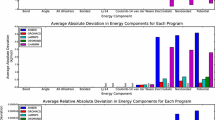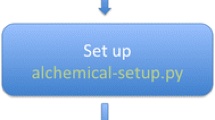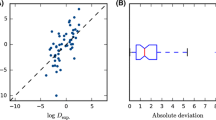Abstract
We report here a test of the Semi-Explicit Assembly (SEA) model in the solvation free energy category of the SAMPL3 blind prediction event (summer 2011). We tested how dependent the SEA results are on the chosen force field by performing calculations with both the General Amber and OPLS force fields. We compared our SEA results with full molecular dynamics simulations in explicit solvent. Of the 20 submissions, our SEA/OPLS results gave the second smallest RMS errors in free energies compared to experiments. SEA gives results that are very similar to those of its underlying force field and explicit solvent model. Hence, while the SEA water modeling approach is much faster than explicit solvent simulations, its predictions appear to be just as accurate.





Similar content being viewed by others
References
Fennell CJ, Kehoe C, Dill KA (2010) Oil/water transfer is partly driven by molecular shape, not just size. J Am Chem Soc 132:234–240
Fennell CJ, Kehoe CW, Dill KA (2011) Modeling aqueous solvation with semi-explicit assembly. Proc Natl Acad Sci USA 108:3234–3239
Nicholls A, Mobley DL, Guthrie JP, Chodera JD, Bayly CI, Cooper MD, Pande VS (2008) Predicting small-molecule solvation free energies: an informal blind test for computational chemistry. J Med Chem 51:769–779
Guthrie JP (2009) A blind challenge for computational solvation free energies: introduction and overview. J Phys Chem B 113:4501–4507
Geballe MT, Skillman AG, Nicholls A, Guthrie JP, Taylor PJ (2010) The SAMPL2 blind prediction challenge: introduction and overview. J Comput Aided Mol Des 24:259–279
Wang J, Wolf RM, Caldwell JW, Kollman PA, Case DA (2004) Development and testing of a general amber force field. J Comput Chem 25:1157–1174
Jorgensen WL, Maxwell DS, Tirado-Rives J (1996) Development and testing of the opls all-atom force field on conformational energetics and properties of organic liquids. J Am Chem Soc 118:11225–11236
Jakalian A, Bush BL, Jack DB, Bayly CI (2000) Fast, efficient generation of high-quality atomic charges. AM1-BCC model: I. method. J Comput Chem 21(2):132−146
Wang J, Wang W, Kollman P, Case D (2006) Automatic atom type and bond type perception in molecular mechanical calculations. J Mol Graph Model 25:247–260
Jorgensen WL, Chandrasekhar J, Madura JD, Impey RW, Klein ML (1983) Comparison of simple potential functions for simulating liquid water. J Chem Phys 79:926–935
Mobley DL, Liu S, Cerutti DS, Swope WC, Rice JE (2011) Alchemical prediction of hydration free energies for SAMPL. J Comput Aided Mol Des. doi:10.1007/s10822-011-9528-8
Bowers KJ et al (2006) Scalable algorithms for molecular dynamics simulations on commodity clusters. In: Proceedings of the 2006 ACM/IEEE conference on supercomputing, New York, SC ’06, ACM
Berendsen HJC, Postma JPM, van Gunsteren WF, Hermans J (1981) Simple point charge water. In: Pullmann B (ed) Intermolecular forces. Reidel, Dodrecht pp 331–342
Shivakumar D, Williams J, Wu Y, Damm W, Shelley J, Sherman W (2010) Prediction of absolute solvation free energies using molecular dynamics free energy perturbation and the opls force field. J Chem Theory Comput 6:1509–1519
Berendsen HJC, van der Spoel D, van Drunen R (1995) GROMACS: a message-passing parallel molecular dynamics implementation. Comput Phys Comm 91:43–56
Hess B, Kutzner C, van der Spoel D, Lindahl E (2008) GROMACS 4: algorithms for highly efficient, load-balanced, and scalable molecular simulation. J Chem Theory Comput 4:435–447
Essman U, Perela L, Berkowitz ML, Darden T, Lee H, Pedersen LG (1995) A smooth particle mesh ewald method. J Chem Phys 103:8577–8592
Miyamoto S, Kollman PA (1992) SETTLE: an analytical version of the SHAKE and RATTLE algorithms for rigid water models. J Comput Chem 13:952–962
Hess B, Bekker H, Berendsen HJC, Fraaije JGEM (1997) LINCS: a linear constraint solver for molecular simulations. J Comput Chem 18:1463–1472
Baker NA, Sept D, Joseph S, Holst MJ, McCammon JA (2001) Electrostatics of nanosystems: application to microtubules and the ribosome. Proc Natl Acad Sci USA 98:10037–10041
Rizzo RC, Aynechi T, Case DA, Kuntz ID (2006) Estimation of absolute free energies of hydration using continuum methods: accuracy of partial charge models and optimization of nonpolar contributions. J Chem Theory Comput 2:128–139
Mobley DL, Dumont E, Chodera JD, Dill KA (2007) Comparison of charge models for fixed-charge force fields: small-molecule hydration free energies in explicit solvent. J Phys Chem B 111:2242–2254
Mobley DL, Bayly CI, Cooper MD, Shirts MR, Dill KA (2009) Small molecule hydration free energies in explicit solvent: an extensive test of fixed–charge atomistic simulations. J Chem Theory Comput 5:350–358
Steinbrecher T, Mobley DL, Case DA (2007) Nonlinear scaling schemes for Lennard−Jones interactions in free energy calculations. J Chem Phys 127:214108
Hess B (2002) Determining the shear viscosity of model liquids from molecular dynamics simulations. J Chem Phys 116:209–217
Acknowledgments
The authors thank Professor David Mobley for helpful discussions. The authors appreciate the support from NIH Grant GM063592.
Author information
Authors and Affiliations
Corresponding author
Electronic supplementary material
Below is the link to the electronic supplementary material.
Rights and permissions
About this article
Cite this article
Kehoe, C.W., Fennell, C.J. & Dill, K.A. Testing the semi-explicit assembly solvation model in the SAMPL3 community blind test. J Comput Aided Mol Des 26, 563–568 (2012). https://doi.org/10.1007/s10822-011-9536-8
Received:
Accepted:
Published:
Issue Date:
DOI: https://doi.org/10.1007/s10822-011-9536-8




